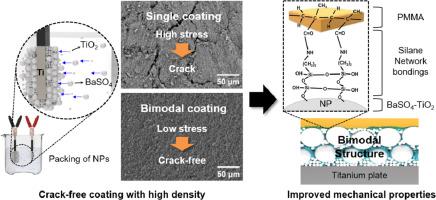Surface & Coatings Technology ( IF 5.3 ) Pub Date : 2021-01-02 , DOI: 10.1016/j.surfcoat.2020.126788 GwangHee Lee , Mi-Jin Jin , Kun-Jae Lee

|
Deliberate control of titanium surfaces such as crack-free and white-color coatings, is one of the key issues for wide range of titanium applications. A white crack-free BaSO4-TiO2 coating with high density was obtained on titanium surface via electrophoretic deposition (EPD) method using BaSO4 and TiO2 with different particle sizes. The crack-free coating was achieved by reducing the shrinkage stress per unit volume acting coating. The effects of the particle size and the mixed condition of the BaSO4-TiO2 were confirmed by comparing the crack size, density and error of the coatings. Additionally, density of the coating was increased by the effect of bimodal particles. The density and thickness of the superior coating are 1.9 ± 0.1 g/cm3 and 12.72 ± 0.63 μm, respectively, under mixed conditions of TiO2: BaSO4 4 g/L: 11.6 g/L. The coating was further covered with 3-aminopropyltriethoxysilane (APTES) silane with tetrathylorthosilicate (TEOS) and polymethyl-methacrylate (PMMA) to improve the mechanical coating properties. The PMMA and silane molecules bonded between the nano- and micro- particles were confirmed through the scanning electron microscopy (SEM) images and Fourier transform infrared (FTIR) spectroscopy. The hardness of the PMMA/Silane/BaSO4-TiO2 composite coating is 0.221 ± 0.017 GPa. Mechanical properties such as the durability and hardness of the coating were improved by the highly packed bimodal structure and complex network bonding between the nano- and micro- particles, silane and PMMA interfaces.
中文翻译:

钛基板上电泳沉积双峰粒子组成的无裂纹PMMA /硅烷/ BaSO 4 -TiO 2复合涂层的结构效应
对钛表面(如无裂纹和白色涂层)的精心控制是广泛应用钛的关键问题之一。使用不同粒径的BaSO 4和TiO 2,通过电泳沉积(EPD)方法在钛表面获得了高密度的白色无裂纹BaSO 4 -TiO 2涂层。通过降低每单位体积作用涂层的收缩应力来获得无裂纹涂层。BaSO 4 -TiO 2的粒径和混合条件的影响通过比较涂层的裂纹尺寸,密度和误差来确定。另外,通过双峰颗粒的作用增加了涂层的密度。在TiO 2:BaSO 4 4 g / L:11.6 g / L的混合条件下,优质涂层的密度和厚度分别为1.9±0.1 g / cm 3和12.72±0.63μm 。涂层进一步用3-氨基丙基三乙氧基硅烷(APTES)硅烷与四甲硅烷基硅酸酯(TEOS)和聚甲基丙烯酸甲酯(PMMA)覆盖,以改善机械涂层性能。通过扫描电子显微镜(SEM)图像和傅里叶变换红外(FTIR)光谱确认了键合在纳米颗粒和微粒之间的PMMA和硅烷分子。PMMA /硅烷/ BaSO的硬度4- TiO 2复合涂层为0.221±0.017GPa。高度填充的双峰结构和纳米与微粒,硅烷和PMMA界面之间的复杂网络键合,改善了机械性能,如涂层的耐久性和硬度。











































 京公网安备 11010802027423号
京公网安备 11010802027423号